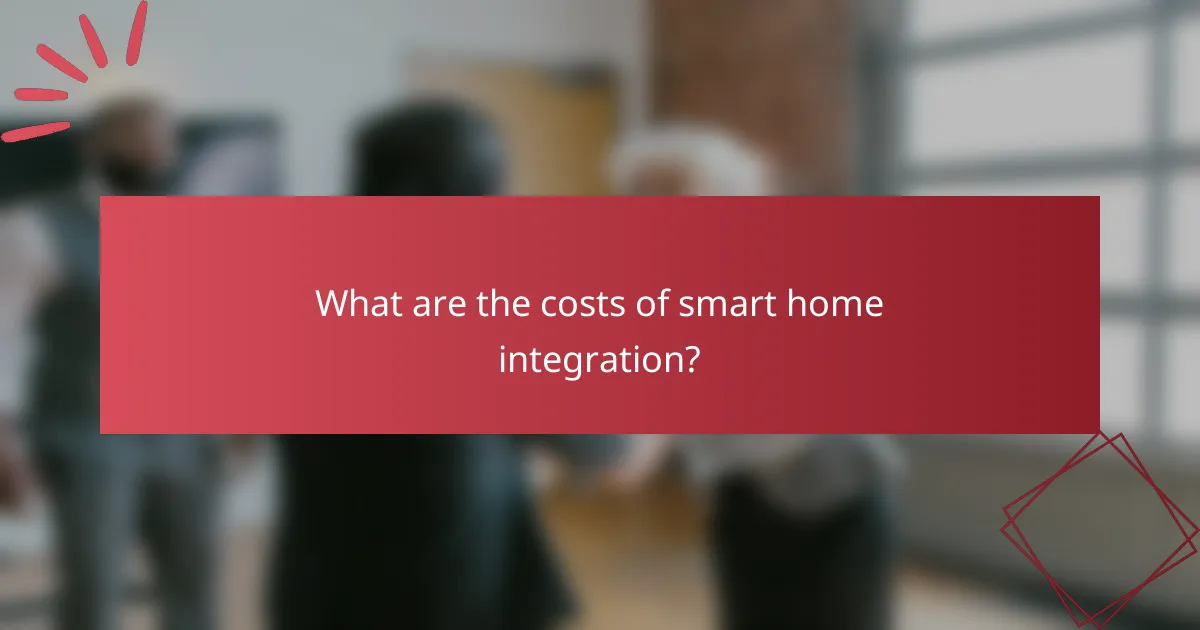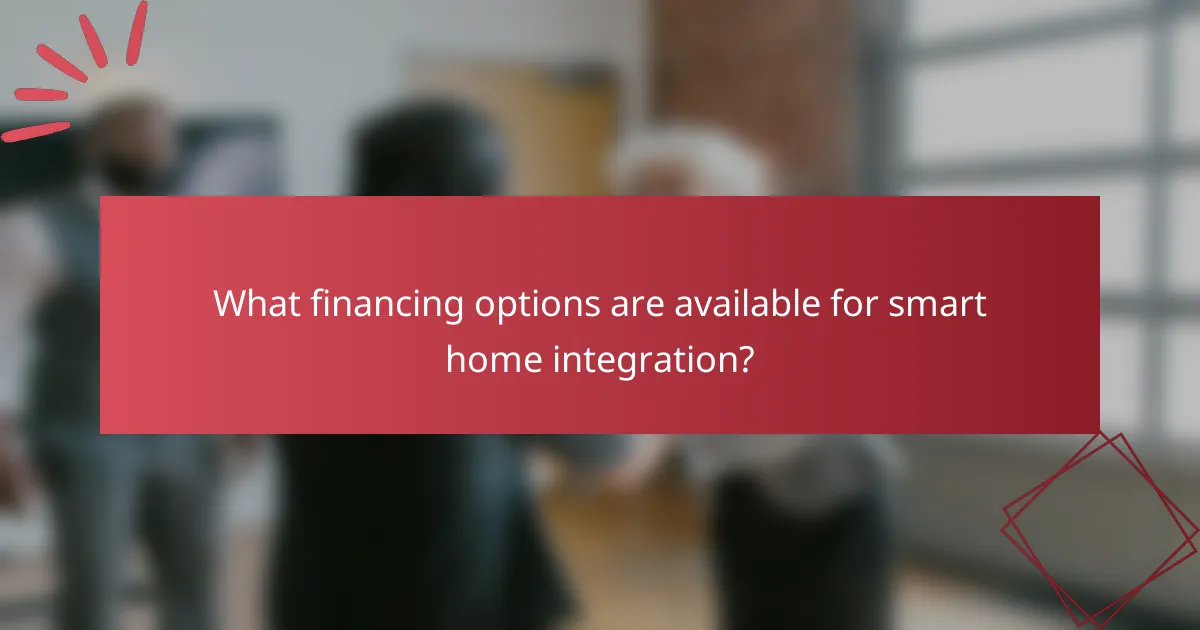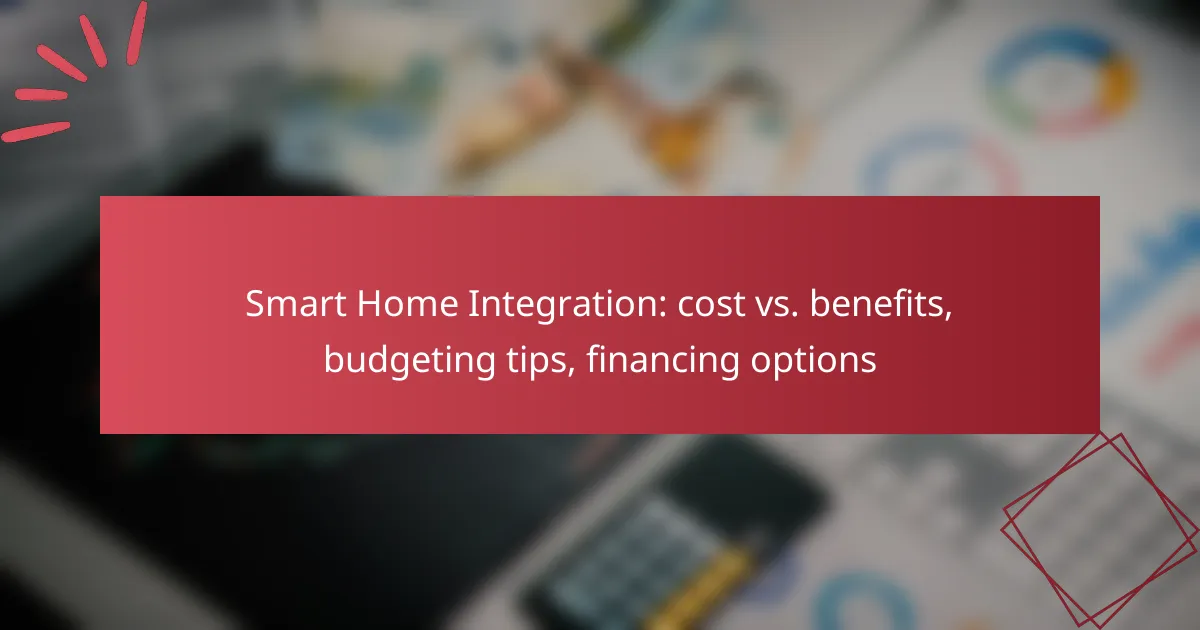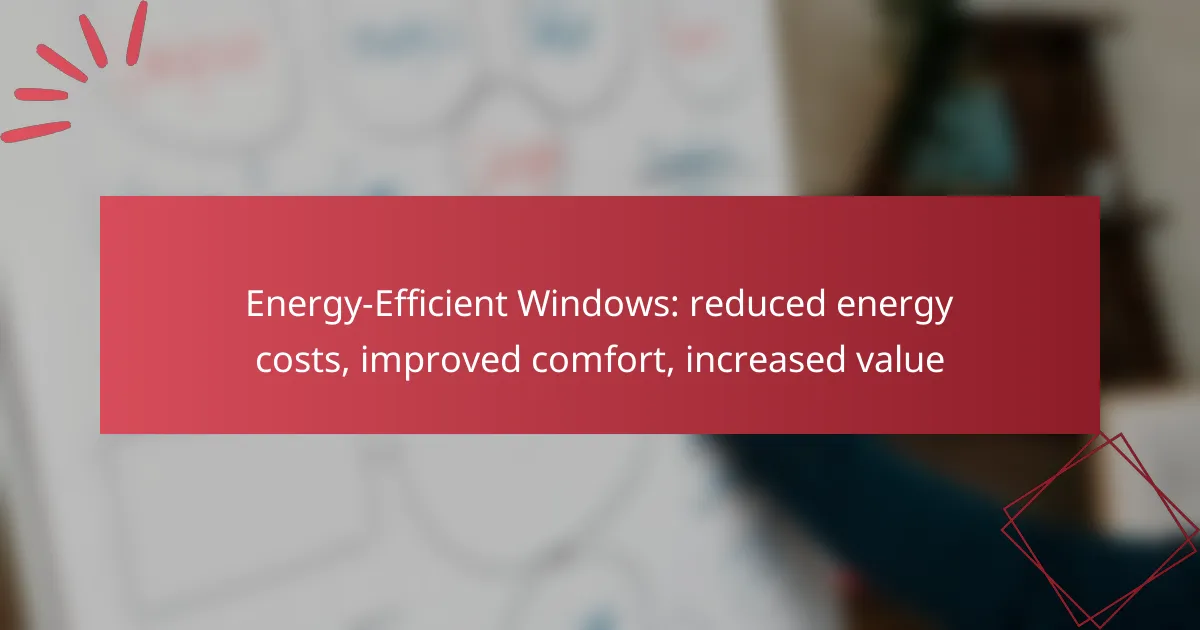Smart home integration presents a unique opportunity to enhance your living experience through improved energy efficiency, security, and convenience. However, understanding the costs involved—ranging from initial setup to ongoing maintenance—is crucial for effective budgeting. By carefully evaluating your needs and exploring financing options, you can make informed decisions that maximize the benefits of your smart home investments.

What are the costs of smart home integration?
The costs of smart home integration can vary significantly based on the technology chosen and the complexity of the setup. Generally, expenses can be categorized into initial setup costs, ongoing monthly fees, and maintenance or upgrade expenses.
Initial setup costs
Initial setup costs for smart home integration typically range from a few hundred to several thousand dollars. This includes the purchase of devices such as smart speakers, cameras, lights, and thermostats, as well as any necessary installation fees. For instance, a basic setup might cost around $500, while a more comprehensive system could exceed $2,000.
When budgeting for initial costs, consider whether you will install the devices yourself or hire a professional. DIY installations can save money, but professional services may ensure proper configuration and integration.
Monthly subscription fees
Many smart home systems require monthly subscription fees for cloud services, advanced features, or security monitoring. These fees can range from $5 to $30 per month, depending on the service provider and features included. For example, a basic security monitoring plan may cost $10 monthly, while a premium plan with additional functionalities could be $30 or more.
Evaluate your needs carefully to avoid unnecessary subscriptions. Some devices offer free basic services, which may be sufficient for many users.
Maintenance and upgrade expenses
Maintenance and upgrade expenses can arise as technology evolves and devices require updates or replacements. Budgeting for these costs is essential, as they can vary widely based on the devices used. Regular software updates may be free, but hardware upgrades can cost anywhere from $100 to $500 or more, depending on the device.
To minimize maintenance costs, choose devices from reputable brands that offer long-term support and updates. Additionally, consider the longevity of the devices you purchase, as investing in higher-quality products can reduce the need for frequent replacements.

What are the benefits of smart home integration?
Smart home integration offers numerous advantages, including enhanced energy efficiency, improved security, and increased convenience. By connecting devices and systems, homeowners can optimize their living environment while enjoying greater control and automation.
Energy savings
Smart home technology can significantly reduce energy consumption by optimizing heating, cooling, and lighting. For instance, smart thermostats can learn your schedule and adjust temperatures accordingly, potentially saving up to 10-15% on energy bills.
Additionally, smart lighting systems allow you to control lights remotely, ensuring they are only on when needed. This can lead to further savings, particularly in larger homes where energy costs can add up quickly.
Increased home security
Integrating smart security devices enhances your home’s safety by providing real-time monitoring and alerts. Smart cameras and doorbell systems allow you to see who is at your door from anywhere, while motion sensors can notify you of unusual activity.
Moreover, smart locks enable you to control access to your home remotely, allowing you to grant entry to guests or service providers without being physically present. This level of control can deter potential intruders and provide peace of mind.
Convenience and automation
Smart home integration simplifies daily tasks through automation and remote control. For example, you can program your coffee maker to start brewing as soon as your morning alarm goes off, or set your blinds to open at sunrise.
Voice-activated assistants can manage multiple devices with simple commands, making it easier to control your environment without manual effort. This convenience can save time and enhance your overall quality of life.

How to budget for smart home integration?
Budgeting for smart home integration involves understanding your specific needs and the associated costs of various technologies. A well-planned budget helps you make informed decisions while maximizing the benefits of your smart home investments.
Assessing your needs
Begin by evaluating what you want to achieve with smart home technology. Consider factors such as security, energy efficiency, convenience, and entertainment. Identifying your primary goals will help you focus on the most relevant products and systems.
Take into account the size of your home and the number of devices you wish to integrate. For instance, a small apartment may only require basic smart lighting and a thermostat, while a larger home might benefit from a comprehensive security system and smart appliances.
Setting a realistic budget
Establish a budget that reflects your financial situation and the scope of your smart home project. Costs can vary widely, with basic setups starting in the low hundreds of USD and more advanced systems reaching several thousand. Research the average prices for the devices you are considering to create a realistic estimate.
Include not only the cost of devices but also potential installation fees, subscription services, and maintenance costs. It’s wise to set aside a contingency fund of about 10-15% of your total budget for unexpected expenses.
Prioritizing features
Once you have a budget, prioritize the features that align with your needs. Focus on essential systems first, such as security cameras or smart locks, before considering optional upgrades like smart speakers or advanced lighting systems. This approach ensures that your initial investment delivers the most value.
Consider the long-term benefits of each feature. For example, investing in a smart thermostat may lead to significant energy savings over time, making it a higher priority than less impactful devices. Create a ranked list of features to guide your purchasing decisions within your budget constraints.

What financing options are available for smart home integration?
Several financing options can help you manage the costs of smart home integration, including home improvement loans, credit card financing, and manufacturer financing programs. Each option has its own benefits and considerations, allowing you to choose the best fit for your budget and needs.
Home improvement loans
Home improvement loans are specifically designed to finance renovations and upgrades, including smart home technology. These loans often come with fixed interest rates and terms ranging from a few years to a decade, making them a stable option for larger projects.
When considering a home improvement loan, check if your lender offers competitive rates and flexible repayment options. Be aware that some lenders may require collateral, such as your home, which can add risk if you fail to repay.
Credit card financing
Credit card financing allows you to purchase smart home devices upfront and pay off the balance over time. Many credit cards offer promotional periods with low or zero interest rates, which can be advantageous if you can pay off the balance before the promotional period ends.
However, be cautious of high-interest rates that can apply after the promotional period. It’s essential to keep track of your spending and ensure you can manage monthly payments to avoid accumulating debt.
Manufacturer financing programs
Many smart home device manufacturers offer financing programs to help customers spread the cost of their products. These programs may include installment plans or special financing offers that allow you to pay over time without high-interest charges.
Before committing to a manufacturer financing program, review the terms carefully. Look for any hidden fees or conditions that could affect the overall cost. Additionally, ensure that the financing aligns with your budget and financial goals.

What smart home systems are popular in the US?
In the US, popular smart home systems include Amazon Alexa, Google Nest, and Apple HomeKit. Each system offers unique features and compatibility with various devices, making them appealing for different user needs.
Amazon Alexa
Amazon Alexa is a voice-controlled smart home system that integrates with a wide range of devices, including lights, thermostats, and security cameras. Users can control these devices through voice commands or the Alexa app, making it convenient for managing home automation.
When considering Alexa, look for devices labeled as “Works with Alexa” to ensure compatibility. A common pitfall is assuming all devices will work seamlessly; always check for integration before purchasing.
Google Nest
Google Nest offers a robust smart home ecosystem that includes smart speakers, displays, and home security products. The system is designed for easy integration with Google Assistant, allowing users to control their devices through voice commands or the Google Home app.
For effective use of Google Nest, prioritize devices that support Google Assistant. Be mindful of the potential need for a strong Wi-Fi connection, as many features rely on internet access for optimal performance.
Apple HomeKit
Apple HomeKit is a smart home platform that focuses on security and privacy, allowing users to control compatible devices through the Home app or Siri. It is particularly appealing for those already invested in the Apple ecosystem, as it works seamlessly with iPhones, iPads, and Macs.
When using HomeKit, ensure that devices are labeled as “Works with Apple HomeKit” for compatibility. A common mistake is overlooking the need for a HomePod or Apple TV to enable remote access to your smart home devices when away from home.

What are the prerequisites for smart home integration?
To successfully integrate smart home technology, you need a reliable internet connection, compatible devices, and a central hub or platform to manage them. Understanding your specific needs and the compatibility of devices is crucial for a seamless experience.
Cost vs. Benefits
When evaluating smart home integration, consider both the initial investment and the long-term savings. Costs can range from a few hundred to several thousand dollars, depending on the complexity and number of devices. Benefits often include energy savings, increased convenience, and enhanced security.
For example, smart thermostats can reduce heating and cooling costs by optimizing usage patterns, potentially saving you 10-30% on energy bills. Weigh these savings against the upfront costs to determine if the integration is worth it for you.
Budgeting Tips
Start by setting a clear budget for your smart home project. Identify which areas of your home you want to automate, such as lighting, security, or climate control, and prioritize them based on your lifestyle and needs. Allocate funds accordingly, keeping in mind that some devices may require professional installation.
Consider starting small with a few key devices and gradually expanding your system. This approach allows you to spread out costs and assess the benefits before committing to larger investments.
Financing Options
Many retailers and manufacturers offer financing options for smart home products, allowing you to spread payments over time. Look for promotional financing plans with low or no interest for a limited period, which can make higher-end devices more accessible.
Additionally, some utility companies provide rebates or incentives for energy-efficient smart devices, which can help offset costs. Research local programs to see if you qualify for any financial assistance when upgrading your home.



